Rodeo Events
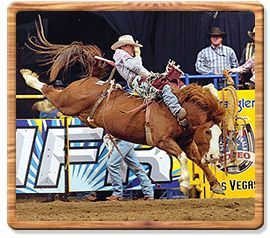
Bareback riding, it has been suggested, offers a sensation about as enjoyable as riding a jackhammer, pogo stick-style, holding on with only one hand.And that’s the easy part. The bareback rider’s real challenge is to look good while he’s being punished. Bareback riding, simply, is the most physically demanding event in rodeo, its toll on the body is immense. Muscles are stretched to the limit, joints are pulled and pounded mercilessly, ligaments are strained and frequently rearranged. The strength of the broncs is exceptional and challenging them is often costly.Bareback riders endure more punishment, suffer more injuries and carry away more long-term damage than all other rodeo cowboys.To stay aboard the horse, a bareback rider uses a rigging made of leather and constructed to meet PRCA safety specifications. The rigging, which resembles a suitcase handle on a strap, is placed atop the horse’s withers and secured with a cinch.As the bronc and rider burst from the chute, the rider has to “mark out” his horse. In other words, he must have both spurs above the horse’s shoulders until the horse’s feet hit the ground after its initial move from the chute. If the cowboy fails to do this, he is disqualified.As the bronc bucks, the rider pulls his knees up, dragging his spurs up the horse’s shoulders. As the horse descends, the cowboy straightens his legs, returning his spurs over the point of the horse’s shoulders in anticipation of the next jump.But it takes more than sheer strength to make a qualifying ride and earn a money-winning score. A bareback rider is judged on his spurring technique, the degree to which his toes remain turned out while he is spurring and his “exposure,” or willingness to lean far back and take whatever might come during his ride.
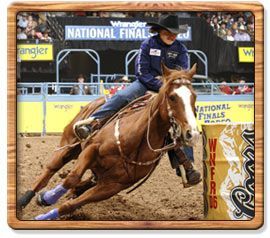 Barrel racing, the only official rodeo event for women regularly scheduled at PRCA sanctioned rodeos, pits the rider and horse against the clock. The origin of barrel racing is unsure. It became popular with ranch women and prompted a charter group of 74 members to form the Women’s Professional Rodeo Association, which is now affiliated with the PRCA. The rider must complete a cloverleaf pattern with three barrels placed approximately one hundred feet apart. Any other pattern will disqualify the rider, and there is a 5-second penalty for every barrel that is knocked over. Each contestant begins at the starting line and completes a full circle around all three barrels. After turning the third barrel, the horse races to the finish line and the official time is taken. The barrel racers often wear very colorful western outfits, sometimes coordinated with matching leg wraps on their horses. They add a great deal of excitement and pageantry to any rodeo.
Barrel racing, the only official rodeo event for women regularly scheduled at PRCA sanctioned rodeos, pits the rider and horse against the clock. The origin of barrel racing is unsure. It became popular with ranch women and prompted a charter group of 74 members to form the Women’s Professional Rodeo Association, which is now affiliated with the PRCA. The rider must complete a cloverleaf pattern with three barrels placed approximately one hundred feet apart. Any other pattern will disqualify the rider, and there is a 5-second penalty for every barrel that is knocked over. Each contestant begins at the starting line and completes a full circle around all three barrels. After turning the third barrel, the horse races to the finish line and the official time is taken. The barrel racers often wear very colorful western outfits, sometimes coordinated with matching leg wraps on their horses. They add a great deal of excitement and pageantry to any rodeo.
 Saddle bronc riding is rodeo’s classic event, both a complement and contrast to the wilder spectacles of bareback and bull riding. Saddle bronc riding evolves from the task of breaking and training horses to work the cattle ranches of the old west. Many cowboys claim riding saddle broncs is the toughest rodeo event to learn because of the technical skills necessary to master it. Every move the bronc rider makes must be synchronized with the movement of the horse. The cowboy’s objective is a fluid ride, as opposed to the wilder and less-controlled ride of bareback riders.Among the similarities shared by saddle bronc riding and bareback riding is the rule that riders must mark out their horses on the first jump from the chute. To properly mark out his horse, the saddle bronc rider must have both heels on the animal’s shoulders when it makes the first jump from the chute. If the rider misses his mark, he receives no score. While a bareback rider has rigging to hold onto, the saddle bronc rider has only a thick rein attached to his horse’s halter. Using one hand, the cowboy tries to stay securely seated in his saddle. If he touches any part of the horse or his own body with his free hand, he is disqualified. Judges score the horse’s bucking action, the cowboy’s spurring action. While striving to keep his toes turned outward, the rider spurs from the points of the horse’s shoulders to the back of the saddle. To score well, the rider must maintain that action throughout the eight-second ride. While the bucking ability of the horse is quite naturally built into the scoring system, a smooth rhythmic ride is sure to score better than a wild uncontrolled one.
Saddle bronc riding is rodeo’s classic event, both a complement and contrast to the wilder spectacles of bareback and bull riding. Saddle bronc riding evolves from the task of breaking and training horses to work the cattle ranches of the old west. Many cowboys claim riding saddle broncs is the toughest rodeo event to learn because of the technical skills necessary to master it. Every move the bronc rider makes must be synchronized with the movement of the horse. The cowboy’s objective is a fluid ride, as opposed to the wilder and less-controlled ride of bareback riders.Among the similarities shared by saddle bronc riding and bareback riding is the rule that riders must mark out their horses on the first jump from the chute. To properly mark out his horse, the saddle bronc rider must have both heels on the animal’s shoulders when it makes the first jump from the chute. If the rider misses his mark, he receives no score. While a bareback rider has rigging to hold onto, the saddle bronc rider has only a thick rein attached to his horse’s halter. Using one hand, the cowboy tries to stay securely seated in his saddle. If he touches any part of the horse or his own body with his free hand, he is disqualified. Judges score the horse’s bucking action, the cowboy’s spurring action. While striving to keep his toes turned outward, the rider spurs from the points of the horse’s shoulders to the back of the saddle. To score well, the rider must maintain that action throughout the eight-second ride. While the bucking ability of the horse is quite naturally built into the scoring system, a smooth rhythmic ride is sure to score better than a wild uncontrolled one.
 Most rodeo events originated on the ranches and cattle drives of the Old West. Roping cattle and riding broncs in competition were natural extensions of ranch work. Climbing aboard a bull, however, was not.
Most rodeo events originated on the ranches and cattle drives of the Old West. Roping cattle and riding broncs in competition were natural extensions of ranch work. Climbing aboard a bull, however, was not.
Many people, in fact, view attempting to ride a surprisingly agile and powerful 2,000-pound bull as a concept that is not totally sane. But those who make their living riding bulls swear by the lifestyle.
“This is it for me. It’s all I ever wanted to do,” said three-time world champion bull rider Tuff Hedeman.
Bull riding requires balance, coordination, quick reflexes, flexibility and perhaps above all else, a positive mental attitude.
The bull rider holds a flat-braided rope during his eight-second ride. In preparation for the ride, he pulls the tail of the rope through a loop, then wraps the rope around his fingers to secure his grip. He nods his head as a signal for the chute gate to be opened and the ride to begin. Each bull has a unique style of bucking. Many bulls spin, or continuously circle in one area of the arena. Others add a jump or kick to their spin, making them more difficult to ride. Still others jump or lunge forward in an attempt to rid themselves of a rider. The cowboy’s control during the ride and the bull’s bucking efforts each account for half of the rider’s score.
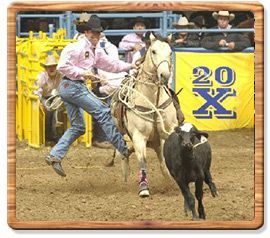 Calf roping, more than any other event in professional rodeo, has roots dating back to the Old West.When a calf was sick or injured, it had to be caught and immobilized quickly for treatment. Ranch hands prided themselves on how fast they could rope and tie calves, and soon they began informal contests. Being quick and accurate with a lasso aren’t the only requirements in calf roping. A successful roper also must be an experienced horseman and a fast sprinter. After giving the calf a pre designated head start, the horse and rider give chase. As the cowboy throws his loop, the horse comes to a stop. After catching the calf, the cowboy dismounts, runs to the calf, throws it to the ground by hand (called “flanking”) and ties any three legs together using a “pigging string” he has carried in his teeth throughout the run. While the contestant is accomplishing all this, the horse must keep slack out of the rope, but not pull it tight enough to drag the calf. If the calf is not standing when the roper reaches it, the cowboy must allow the calf to stand and then flank it before making the tie.
Calf roping, more than any other event in professional rodeo, has roots dating back to the Old West.When a calf was sick or injured, it had to be caught and immobilized quickly for treatment. Ranch hands prided themselves on how fast they could rope and tie calves, and soon they began informal contests. Being quick and accurate with a lasso aren’t the only requirements in calf roping. A successful roper also must be an experienced horseman and a fast sprinter. After giving the calf a pre designated head start, the horse and rider give chase. As the cowboy throws his loop, the horse comes to a stop. After catching the calf, the cowboy dismounts, runs to the calf, throws it to the ground by hand (called “flanking”) and ties any three legs together using a “pigging string” he has carried in his teeth throughout the run. While the contestant is accomplishing all this, the horse must keep slack out of the rope, but not pull it tight enough to drag the calf. If the calf is not standing when the roper reaches it, the cowboy must allow the calf to stand and then flank it before making the tie.
When the roper has completed his tie, he throws his hand in the air as a signal to the flag judge. He then remounts his horse and rides toward the calf, making the rope slack. The calf must remain tied for six seconds after the rope is slack or the cowboy will receive a “no time”.
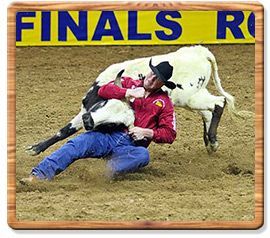 Speed is the name of the game in steer wrestling. With its modern world record sitting at 2.4 seconds, steer wrestling is the quickest event in rodeo. As with calf ropers and team ropers, the bulldogger starts on horseback in a box. A breakaway rope barrier is attached to the steer, then stretched across the open end of the box. The steer gets a head start that is determined by the size of the arena. When the steer reaches the advantage point, the barrier is released and the bulldogger takes off in pursuit. If the bulldogger breaks the barrier before the steer reaches its head start, a 10-second penalty is assessed.
Speed is the name of the game in steer wrestling. With its modern world record sitting at 2.4 seconds, steer wrestling is the quickest event in rodeo. As with calf ropers and team ropers, the bulldogger starts on horseback in a box. A breakaway rope barrier is attached to the steer, then stretched across the open end of the box. The steer gets a head start that is determined by the size of the arena. When the steer reaches the advantage point, the barrier is released and the bulldogger takes off in pursuit. If the bulldogger breaks the barrier before the steer reaches its head start, a 10-second penalty is assessed.
In addition to strength, timing and balance are skills cultivated by the successful steer wrestler. When the cowboy reaches the steer, he slides down the right side of his galloping horse, hooks his right arm around the steer’s right horn, grasps the left horn with his left hand and, using strength and leverage, wrestles the animal to the ground. His work isn’t complete until all four of the animal’s feet face upward. But that’s still not all there is to it. In order to catch up to the running steer, the cowboy uses a “hazer,” another mounted cowboy who gallops his horse along the right side of the steer, keeping it from veering away from the bulldogger.
The hazer can make or break a steer wrestler’s run, so his role is as important as the skills the bulldogger hones. For that reason, and the fact a hazer sometimes supplies the bulldogger a horse, the hazer usually receives a fourth of the payoff if the steer wrestler places.
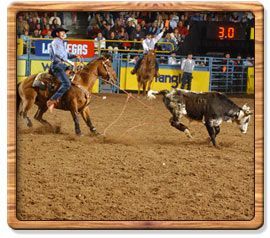 Team roping, requires close cooperation between two highly skilled ropers, a header and a heeler. The event originated on ranches when cowboys needed to treat or brand large steers and the task proved too difficult for one man.
Team roping, requires close cooperation between two highly skilled ropers, a header and a heeler. The event originated on ranches when cowboys needed to treat or brand large steers and the task proved too difficult for one man.
The key to success? Hard work and endless practice. The partners must perfect their timing, both as a team and with their horses. As in calf roping or steer wrestling, the team ropers start from the boxes on each side of the chute from which the steer enters the arena. The steer gets a head start determined by the length of the arena. One end of a breakaway barrier is attached to the steer then stretched across the open end of the header’s box. When the steer reaches its advantage point, the barrier is released and the header takes off in pursuit, with the heeler trailing slightly further behind. If the header breaks the barrier before the steer completes its head start, the ropers are assessed a 10-second penalty. The header ropes first and must make one of three legal catches on the steer – around both horns, around one horn and the head, or round the neck. Any other catch by the header is considered illegal and the team is disqualified. After the header makes his catch, he turns the steer to the left and exposes the steer’s hind legs to the heeler. The heeler then attempts to rope both hind legs. If he catches only one foot, the team is assessed a five-second penalty. After the cowboys catch the steer, the clock is stopped when there is no slack in their ropes and their horses face one an other.
Events
Calaveras Big Trees State Park | 12:00 pm - 3:00 pm
Christmas Light Show
Christmas light show | 6:00 pm - 9:00 pm
Calaveras Big Trees State Park | 12:00 pm - 3:00 pm
Christmas Light Show
Christmas light show | 6:00 pm - 9:00 pm
Calaveras Master Gardeners Demonstration Garden | 11:00 am - 4:00 pm
Warming Hut
Calaveras Big Trees State Park | 12:00 pm - 3:00 pm
